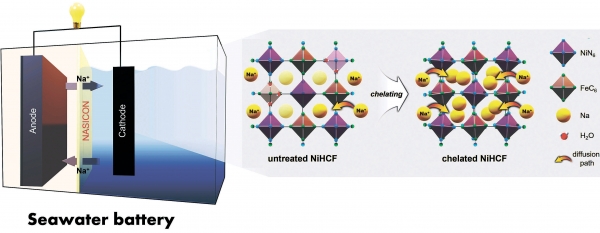
70% of the Earth’s surface is taken up by water, and 97% of that water consists of seawater. The seawater’s abundance is drawing attention to it as ‘the’ energy resource for the next generation.
Recently the research team of Professor Changshin Jo (GIFT, CE) and Hyebin Jeong (Ph.D. candidate in CE) identified the outstanding performance of chelating agent-applied seawater batteries (SWBs). The research was published recently in the international journal Chemical Engineering Journal.
Lithium-ion batteries are widely used in mobile electronics and electric vehicles. But it has a danger of explosion and can no longer be made once lithium is depleted. To overcome these limits, the development of next-generation-battery is actively in progress. One of the batteries in development is SWB, which uses Na-ions in the seawater to charge and discharge energy. This method is eco-friendly since it uses seawater without any treatment, and the abundance of seawater makes the supply of resources easier.
Na-ion generates and stores electric energy by moving between the positive and negative electrodes of the SWB. Nickel hexacyanoferrate (NiHCF), used as an intercalation cathode material for SWBs, is often manufactured in a defect-rich structure. The research team synthesized chelating agent to NiHCF (sample A) and compared this sample to the control sample (sample B).
Observing the two samples with a microscope, microscope, the morphological and structural difference between the two samples was prominent. The size of the primary particle is smaller in sample B, but because it is condensed together to form a bigger chunk, sample B is less efficient in homogeneous dispersion in electrode-scale. In addition, when comparing the electrochemical performance of the samples, they found that sample A exhibited higher energy efficiency and capacity than sample B. The team also tested long-term cycling performance of two samples for 2,000 cycles. The result of the battery using sample A showed higher capacity retention of 92.8%. It is mainly owing to the lowered defect ratio of NiHCF, which is decreased by 6% in sample A.
In conclusion, the research team confirmed the excellence in performance of seawater battery by applying chelating agent into the formation of Prussian blue analogue cathode. This outcome is anticipated to be an accelerator for the research of next-generation batteries.


